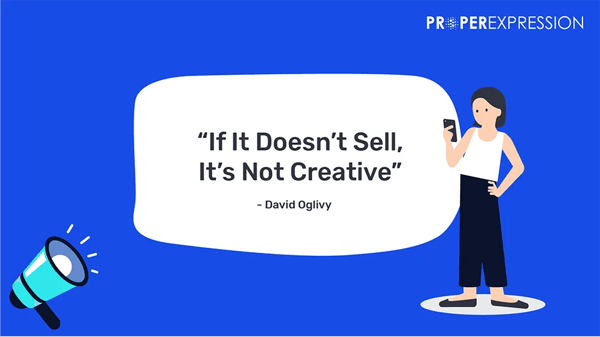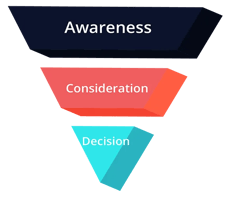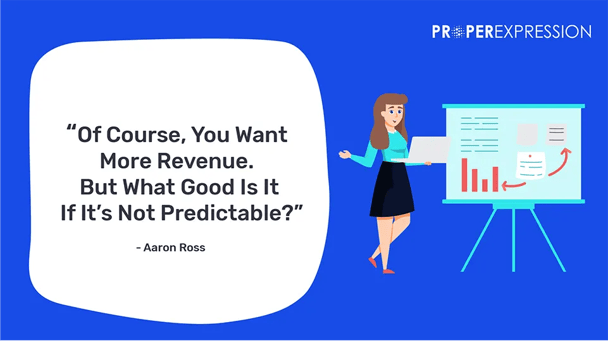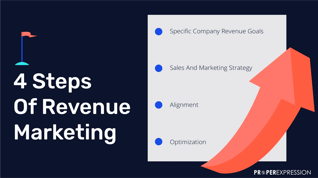Table of Contents
There are a thousand ways to measure marketing from impressions to share-of-voice - from time on-site to pages per session - but in the end, marketing has one job: to drive new opportunities for sales to turn into revenue.
Building a revenue-focused marketing organization for your company means turning your attention to the metrics that matter (revenue, profitability, etc.) and enabling marketing to develop a strategy that focuses on those metrics.
By directly aligning marketing to bottom-line metrics, companies empower their marketing teams to develop and execute winning growth marketing strategies to fully contribute to the company's progress instead of focusing on vanity metrics that may have little to no influence on the actual bottom line.
But building and running a revenue marketing organization takes the commitment of the entire company. Without precise alignment of all departments in the organization, marketing teams often struggle to get the information, buy-in and means they need to meet revenue KPIs.
To build a truly successful revenue marketing engine, each member of the C-suite has a part to play.
In this five-part guide, we break down the basics of revenue marketing, and how each member of the C-suite can contribute to creating a successful revenue marketing organization.
I. The Basics of Revenue Marketing
Like Chris Anderson, Curator of TED, once said: "Nail the basics first, detail the details later." To be successful with any form of marketing, especially revenue marketing, you need a thorough understanding of its foundation. So before looking at tactics, let's dive into what revenue marketing is and how marketers leverage it to generate revenue.
What is Revenue Marketing?
Revenue marketing is an approach to marketing that focuses directly on driving revenue. We can contrast this with other forms of marketing, such as lead generation, where revenue is a by-product of your team’s efforts.
Common tactics within revenue marketing include:
- The strategic alignment of sales and marketing around a shared goal of revenue generation
- An increased emphasis on data and analytics to track and optimize marketing’s influence on revenue
- A strategic emphasis on areas which will drive the largest revenue increase, which may be new customer acquisition or increasing existing customer loyalty
However, the precise set of channels and tactical decisions a revenue marketer makes will stem from their revenue strategy.
What's a Revenue Strategy?
Prior to asking a marketing team to generate revenue, executives will want a revenue strategy for the entire company. A revenue strategy refers to a team's plan of action for maximizing short and long-term sales-generating goals which increase the company's overall profit and income. According to The Personal MBA author Josh Kaufman, increasing revenue require a focus on improving at least one of the following:
- Average transaction size
- Your customer pool (number of customers)
- Your prices
- Frequency of transactions per customer
As you can see, a revenue strategy is far from being focused on lead gen, channels, and conversion rates. Rather, it focuses on product line pricing and profitability, LTV, etc.
When drafting a revenue strategy, here are some questions that should be answered:

- Are the conversion rates from visit all the way to close the same across product lines?
- What sells best?
- What closes quickest?
- What's the most profitable?
- What's the most valuable long-term?
- Are there opportunities to upsell and cross-sell existing customers?
- Is there an opportunity to significantly increase volume by lowering the price?
- Is there an opportunity to increase revenue by increasing prices?
- Is there an opportunity to reduce time-to-close across the board?
Before getting started with a revenue strategy, companies understand the following metrics for each of their products and services:
- Average CAC
- Average LTV
- ACV
- Average sales cycle time
What's Revenue Generation Marketing?

Revenue marketing is a holistic approach to marketing that focuses every strategy, tactic and initiative toward a singular goal: driving revenue.
Revenue marketing is not a specialty, like Demand Gen, Marketing Ops, Brand Marketing, Event Marketing, etc., but rather a philosophy that aligns all marketing specialties and tactics into a comprehensive plan that drives attributable impact to the bottom line.
Through that emphasis, marketing turns from a cost into an investment that predictably generates the revenue the business needs to sustain and grow.
Is Marketing Responsible for Revenue (And Should it Be)?

That’s a question we like a lot at ProperExpression.
In traditional B2C structures, marketing is definitely responsible for revenue. “How much of the product is getting off the shelves?” “How much lift did this campaign generate?” These are questions that B2C marketers have had to answer for a very long time.
In B2B, things get murkier. But even if the industry has been slow to pick up on the trend, leaders like Paul D’Arcy, CMO of Miro, have been writing about revenue marketing since 2012, so we are far from new territory here.
What we are seeing, however, is an increasing number of companies focusing on marketing's impact on revenue and revenue attribution. And while marketing teams don’t close deals, they can certainly both contribute to the bottom line and prove it.
Before the birth of digital marketing, the impact of marketing on sales was really difficult to assess. With digital marketing though, we turned a corner. Everything became measurable. Or at least, that has become the expectation. Of course, the reality is much more nuanced. Measuring the impact of every marketing dollar on the bottom line is much more complex than it might appear.
That being said, the tools that we now have at our disposal, along with the traditional tactics of using correlations and measuring lift, enable marketers to provide more transparency into their contribution to the bottom line than ever before. With this ability comes faster growth for the company and a better seat at the table for marketers. That’s a win-win!
How Do Marketers Generate Revenue?
The first step for any marketer to generate revenue is to have an excellent understanding of their revenue strategy.
Based on that strategy, marketers can generate revenue by either:
- Creating new business
- Generating additional revenue through existing business
Sophisticated revenue marketing teams will craft strategies for both avenues.
For either approach, they will need to carefully consider the Sales and Marketing Funnel, understand where the bottlenecks and major opportunities are and work in tandem with sales to strategically craft programs that optimizes the entire funnel.
Based on that plan (and only after they have that plan), they create marketing campaigns that leverage different channels (ads, organic, etc.) to distribute curated content (blogs, eBooks, one-pagers, videos) to build subscribers and convert them down the funnel to leads, MQL, etc. — all the way to customer.
For more details about how marketers can generate revenue, read our blog: 6 ways to Jumpstart your Revenue Marketing Today!
What’s a Marketing Funnel Strategy?
 A Marketing Funnel Strategy often refers to the process of aligning your messages to the three stages of your buyer's journey:
A Marketing Funnel Strategy often refers to the process of aligning your messages to the three stages of your buyer's journey:
- Awareness — In this stage, your marketing messages should appeal to consumers who are just getting comfortable with their problem and the brand/product options available to resolve it. They're just becoming "aware" of you and the competition. Marketers often use social media, blogs, paid social ads, and paid search ads to bring more awareness in this stage.
- Consideration — Now that the consumer is aware of your brand and product, they are considering their options (i.e., what do you offer over the competition? What makes you the better choice?). Many marketers establish expertise in their industry for this stage, using blog guides, webinars, targeted ads and FAQs to stand out.
- Conversion/Purchase — By the third stage, your consumer has converted into your customer. The marketer's job does not end here, though. It's important to nurture that relationship to encourage loyalty and repeat purchases. Many marketers look to referral programs and special bundles to strengthen the connection between brand and consumer.
What's the Difference Between Revenue Marketing and Demand Generation?

Demand and lead generation programs are most often laser-focused on bringing new leads into the pipeline. The KPIs in these processes tend to revolve around creating MQLs or SQLs. However, focus on such metrics can incentivize the wrong sorts of behaviors:
- Passing leads to sales before they are ready.
- Paying very little attention to "old" leads that are already familiar with the brand.
- Under-leveraging existing databases and contacts
Concentrating on only MQL and SQL-related metrics can also put marketing at a disadvantage, as not all departments are as focused on these KPIs. Instead, shifting the mindset to track and improve metrics that are impactful company-wide can enable marketing to speak the same language as the other departments, furthering the efforts for alignment.
Revenue marketing focuses on exactly what it indicates: driving revenue.
While revenue marketing uses some of the same tactics as demand gen, it utilizes a more holistic approach and creates a more cohesive go-to-market strategy.

Revenue marketing considers one key factor that is often neglected in lead gen plans: time-to-close (or sales cycle time). Most revenue marketers will understand, for example, that if it takes 2 months to move a lead from awareness to consideration, and 6 months from opportunity to close, most of their revenue target depends on the leads that are already in their database. Comprehension of this data will empower marketers to better understand the company goals and which activities best support these goals. They can then put more effort toward nurturing existing leads while simultaneously filling the funnel with fresh leads for the sales team.
While revenue marketing uses some of the same tactics as demand gen, it utilizes a more holistic approach and creates a more cohesive go-to-market strategy.
Revenue Marketing vs. Marketing ROI
 Although many mistake revenue marketing and return-on-investment (ROI) as one and the same, the two marketing terms are certainly not. Instead, think of them as simply related. Revenue marketing refers to the plan of actions and marketing methods you intend to execute to increase your overall revenue. On the other hand, marketing ROI refers to the efficiency of the investment you pursue. This efficiency is calculated via this formula:
Although many mistake revenue marketing and return-on-investment (ROI) as one and the same, the two marketing terms are certainly not. Instead, think of them as simply related. Revenue marketing refers to the plan of actions and marketing methods you intend to execute to increase your overall revenue. On the other hand, marketing ROI refers to the efficiency of the investment you pursue. This efficiency is calculated via this formula:
(Sales Growth — Marketing Cost) / Marketing Cost = Marketing ROI
Take, for instance, social media. You will want to track metrics like engagement, brand awareness and traffic driven as channel-specific metrics that will tell you if your social media tactics are working. However, you’ll only know if your social media strategy as a whole is successful when you look at how it influenced closed deals and revenue.
Both revenue marketing and ROI goals are essential to marketing success. Together, they make up the foundation of which marketing efforts do and do not work as revenue drivers for your brand. This, in turn, allows your business to pursue only profitable investments.
4 Stages of Revenue Marketing

- Create specific, measurable, and attainable company revenue goals
- Develop a sales strategy that seems most likely to meet those goals
- Align your marketing strategy with the sales strategy
- Optimize and refine your marketing to better drive revenue
II. The Role of the C-suite In Revenue Marketing
 Revenue marketing brings significant growth potential to a business and its bottom line, but it requires the whole company comes together to support the revenue-focused effort.
Revenue marketing brings significant growth potential to a business and its bottom line, but it requires the whole company comes together to support the revenue-focused effort.
In fact, Review 42 reports that 81% of companies that beat their revenue goals are "somewhat" or "completely" aligned. The report also found that 56% of aligned companies meet their revenue goals, and an additional 19% manage to beat their targets.
Unfortunately, alignment can be elusive to achieve. To help you through your revenue marketing journey, we outlined how every member of the C-suite can provide marketing teams with the tools and support they need to drive revenue.
The CEO: The MVP of Revenue Marketing
 Regardless of whether they have a marketing background, CEOs play a key role in revenue marketing.
Regardless of whether they have a marketing background, CEOs play a key role in revenue marketing.
They set the overall company goals and strategy, align all of the teams and make it a priority for each team to support one another.
The first step is to set goals for marketing with revenue in mind: asking marketing to increase the share of voice and then measuring them on how revenue is working at cross purposes.
Here are 4 ways CEOs can directly influence marketing teams’ success:
- Leverage the GOST (Goal Objective Strategy Tactics) framework to set clear and measurable goals and objectives for the entire company and highlight the role of each department in attaining the goals.
- Institute a culture of transparency and accountability. Key metrics like Sales Cycle Time, Profitability per Product Line or Level, CAC, Close Rates, and more should be available to all C-level executives and strategic planners as appropriate.
- Regroup and re-adjust the strategy with their team regularly based on data and new findings.
- Establish a culture of active cross-departmental collaboration.
This role is the MVP of revenue marketing because they keep the C-suite on the same track. This includes keeping the communication between C-suites regular, consistent and accessible.
The CRO: The Revenue Marketing Optimizer
The role of the CRO is to communicate and align all the departments on the common revenue goal.
With a clear understanding of which products and services are the company's most efficient revenue and profit drivers, CROs can inform marketing teams as they are building their plans for the year.
Here are 4 ways CROs can help marketing teams optimize their revenue strategies:
- Create a revenue plan based on product sales to inform the marketing strategy.
- Establish an active line of communication between product development, marketing and sales.
- Create transparent revenue reports that link marketing and sales efforts to product sales.
- Use input from marketing and sales to drive future product or service development and growth.
The CSO: The Brains Behind the Operation in Revenue Marketing
The role of the CSO is to know the funnel inside and out and know how the sales pipeline plays out. If they want to drive revenue this year, they can't focus their marketing efforts on products with a 12-month lead-to-close. They want leads in all stages of the funnel, so they need to understand the funnel. They also need to know which leads are most likely to close. Their company might have a seven-figure product that everyone wants to buy, but if they only close 1% of those leads, then too many of those leads will be wasting their time.
The CMO: The Competitive Advantage in Revenue Marketing
 The role of the CMO is to identify and communicate areas that bring a competitive advantage to your brand and business. The CMO needs to understand how to turn a marketing team into a revenue marketing team. High on this list is how to turn revenue and sales goals into channel-specific metrics, allowing for more efficient channel optimization with fewer wasted cycles. This will give their company the competitive advantage it needs to ensure they're not only staying well within their budget but investing in areas that reach and resonate with the right target audience.
The role of the CMO is to identify and communicate areas that bring a competitive advantage to your brand and business. The CMO needs to understand how to turn a marketing team into a revenue marketing team. High on this list is how to turn revenue and sales goals into channel-specific metrics, allowing for more efficient channel optimization with fewer wasted cycles. This will give their company the competitive advantage it needs to ensure they're not only staying well within their budget but investing in areas that reach and resonate with the right target audience.
Achieve Revenue Generation Marketing Success with ProperExpression
With the right plan in place, any company can allow for marketing to go from a revenue black box to a clear revenue driver for the company. The key is to align your company. According to Inc., you need to break down the silo (departments working separately and individually towards a goal) to increase your revenue. Their report found that when you do, you benefit from "an average of 32% annual revenue growth while less aligned companies reported an average 7% decline in revenue."
Each team member has a role to play in making it happen:
- CEO: sets company goals and stays focused on them. Don't get distracted by unrelated metrics.
- CSO: Help marketing understand the sales process to generate better leads that are more likely to close.
- CRO: Build a tech stack that provides reporting you trust that can inform everyone on which activities are truly driving revenue.
- CMO: Build your strategy around the company goals to tie all your activities back to those goals. Focus your marketing on what matters for your company.
If you'd like more insight into how you can achieve revenue marketing success, talk to the experts at ProperExpression. In the meantime, download the Revenue Marketing Workbook Template Bundle to help your organization become a revenue marketing company.
For more information on revenue marketing agencies and how other types of growth marketing agencies can help your business, read our Ultimate Guide to Growth Marketing Agencies!
Enter Hypergrowth
Get in touch today and learn how we can help you achieve your goals!
SOLUTIONS
ABOUT
Enter Hypergrowth
Get in touch today and learn how we can help you achieve your goals!









